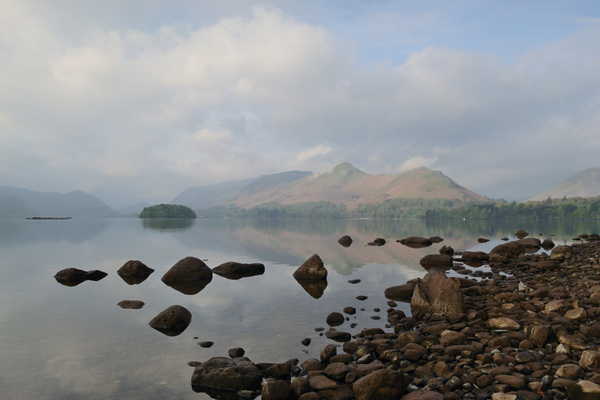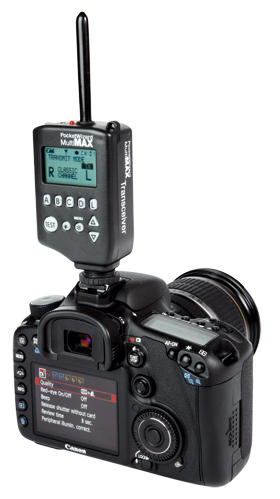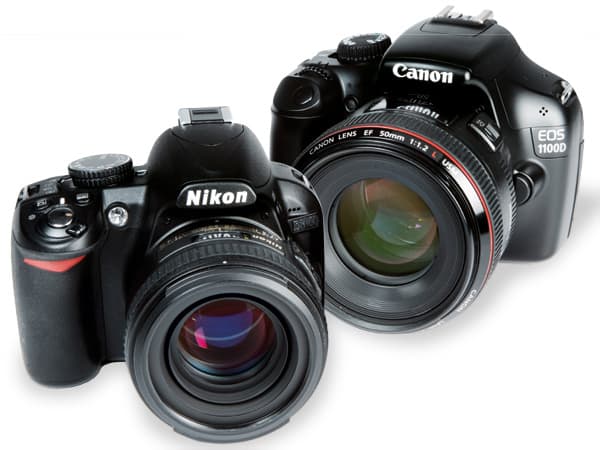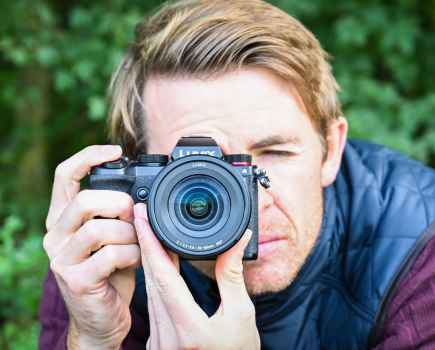
Image: The entry-level offerings from Canon and Nikon fitted with the more professional Canon EF 50mm f/1.2L and Nikkor 50mm f/1.4 lenses
Many enthusiast photographers look on in envy at the images taken by ‘professional’ photographers, and assume that only prohibitively expensive gear can produce such results. However, this is something of a misapprehension because, on most occasions, the results are down to the skill of the photographer. The humble entry-level DSLR is just as capable of producing ‘professional’-quality images, and at a lower cost, which can only be a good thing in these days of VAT rises, scrimping and saving.
To illustrate their ability to produce professional-quality images, I looked at Canon’s EOS 1100D and Nikon’s D3100 budget entry-level DSLRs. Both have a street price of around £450 with a kit lens, compared to around £1,500 for their APS-C-format counterparts, such as the Canon EOS 7D and Nikon D7000. Not only are the 1100D and D3100 much less expensive, but they’re also compatible with a wide selection of top-quality optics. Furthermore, the resolution of the sensors in entry-level models now equate to those once fitted to professional models, such as the Nikon D2X, a mere five years ago. In essence, the imaging sensors in the likes of the 1100D and D3100 are good enough to produce high-quality results so long as the camera is paired with a good lens.
I pitched these leading entry-level DSLRs against each other, looking at the applications that are most suitable in a professional context, which camera best accommodates the professional, and finally, which model offers most scope for nurturing and developing professional skills.


Images: The sensors of both the Canon EOS 1100D and Nikon D3100 are capable of resolving a good level of detail. Using a 50mm prime lens provides a good perspective, sharp focus and shallow depth of field, which are all ideal for food photography.
Features
Both cameras have an APS-C-size sensor. The EOS 1100D’s sensor measures 22.2×14.7mm and is slightly smaller than the standard APS-C size, which is generally 23.1×15.4mm and the size featured on the D3100. The difference is so tiny that in terms of image quality it is almost unnoticeable.
However, it does have a small effect on the multiplication factor of the lens. Using a 50mm lens, the effective focal length of Canon’s 1.6x factor equates to 80mm, whereas Nikon’s 1.5x factor gives a 75mm equivalent from the same lens.
One advantage for the Nikon D3100 is its 14.2-million-pixel sensor, which has two million more photosites than that of the 1100D. The maximum image output is 4272×2848 pixels for the 1100D and 4608×3072 pixels for the D3100. This allows the Nikon to produce prints that are about 1in larger at 300ppi without interpolation. However, the level of detail is another matter.
When the 1100D and D3100 are compared to their most sophisticated APS-C-size counterparts, the differences are rather small. In the Nikon range, although sensor sizes are virtually the same, the 16.2-million-pixel Nikon D5100 and D7000 offer two million more pixels than the D3100, while the older D300S has 12.3 million pixels. The differences between Canon models are more obvious, with the 18-million-pixel EOS 600D and EOS 7D having almost six million more pixels than the 1100D.
Basic raw conversion software is provided with most cameras that shoot raw files, and the Nikon D3100 is no exception. However, for more advanced raw editing, Nikon’s Capture NX2 can be brought separately. Canon bucks this trend by providing its Digital Photo Professional software, which offers full editing control, for free with the 1100D.
Build and handling
Entry-level camera bodies are usually made of less expensive materials than the bodies of enthusiast-level cameras.
In this instance, the Canon EOS 1100D and Nikon D3100 are made of polycarbonate rather than the tougher and costlier magnesium alloy of enthusiast-level DSLRs.
However, both cameras are solid and have the advantage of being a good 50% lighter and 20% smaller than the magnesium-alloy-bodied models. The D3100 is slightly smaller than its predecessor, the D3000, and the 1100D, but they weigh virtually the same when a battery is inserted. The 1100D is bigger than its forerunner, the 1000D, and the EOS 600D.

Image: Nikon D3100 sample image. Both cameras are lightweight, which makes them a good option for a long day out shooting landscapes

Image: Canon EOS 1100D sample image. Both cameras are lightweight, which makes them a good option for a long day out shooting landscapes.
With its rubberised handgrips and textured body, photographers used to a more professional body will feel at home with the D3100. The 1100D has a smooth finish all over, and consequently feels a little ‘cheaper’ in the hand, despite its identical price tag.
Although targeted at photographers of the same level, there is a clear difference between the way the buttons are laid out on the two cameras. For example, the D3100 has small buttons that protrude from the body, while the 1100D’s larger buttons are flush with the body and have distinct white labels. However, both sets of buttons are easily operated.
Unlike the 1100D, the D3100 does not have direct access to ISO or white balance, which is something professional photographers would find frustrating. One of these options can be assigned to the function (Fn) button on the front of the body, although this is a less intuitive method of control. Otherwise, these controls are accessed on the LCD screen via the ‘i’ button, which means taking your eye away from the viewfinder. What is unique to the D3100 compared to other cameras at this level is the drive mode lever, next to the shooting mode dial. This is handy for quick access to continuous and self-timer modes.
Users familiar with Canon or Nikon systems will immediately notice that the menus of the 1100D and D3100 have the same formats as those of their senior counterparts, and new users should not take long to get to grips with what is on offer. These models are geared for the beginner and encourage auto functions, leaving the in-camera menu less populated.
Nikon’s D3100 has a handy guide mode section. While experienced photographers may not need to use this, beginners will find it useful to understand the basics of photography. It is very interactive, using handy visual prompts, and should encourage the new photographer to develop these skills to a professional level of understanding.
Canon’s guide takes the form of one-line descriptions in each setting, which is helpful, too, but much more reminiscent of a compact camera, explaining the various modes. Of the two, the D3100’s guide system is better and also offers visual guidance in the shooting menu, with a diagram to show the effect of changing the aperture on the lens.
There is a lot to be said for setting up your camera to get the best results. Most entry-level cameras will be set up for print-ready images, which can mean they overexpose by at least 1/3EV to give brighter images at the risk of blown-out highlights. Both the 1100D and D3100 offer exposure compensation of up to ±5EV in 1/3EV steps should you need to make any adjustments to the exposures. Nikon’s dynamic range optimiser (DRO) and Canon’s auto lighting optimiser (ALO) are available and fill in a bit of detail to shadow and highlight areas.
Being able to shoot in an uncompressed raw format is essential at a professional level, to allow for the most control over post-capture exposure adjustments. Simultaneous raw and JPEG capture is possible in each camera for the best of both worlds.
For those who frequently use tripods, the position of the memory-card slot and the battery in the bottom of the body of the 1100D may occasionally prove to be an irritation. This is because changing a memory card may require removing the camera from the tripod, depending on the size of the quick-release plate and the design of the tripod.
When shooting with the two models, I found that each camera has unique benefits over the other. For instance, the EOS 1100D can bracket for white balance and exposure. Furthermore, it offers depth of field preview and a histogram in live view, both of which are missing from the Nikon D3100. What the D3100 does offer, though, is quick and intuitive access to drive modes through the switch, while a quiet mode enables more discreet shooting. The exposure compensation control is also well placed next to the shutter-release button switch. What compensates for the D3100’s lack of raw editing software, to a degree, is a much greater scope for in-camera raw file conversion and manipulation, with output size, compression, white balance, exposure comp, picture control, noise reduction, colour space and D-lighting all available for correction after shooting.
The D3100’s built-in flash is more powerful, with a GN of 13m @ ISO 100 (with manual setting) and matches other cameras in the Nikon DSLR range, while the EOS’s 1100D’s GN of 9.2m @ ISO 100 falls a little short. Most ‘pro’ cameras don’t feature pop-up flash because many users will instead opt for an external flashgun and these are considered weak points. Both cameras support wireless flash, but don’t feature wireless controllers. In contrast, both Canon’s EOS 7D and Nikon’s D7000 offer fantastic wireless flash control, which is an advantage over entry-level models.
Performance
For the purposes of this test I have used professional-grade lenses instead of the standard kit lenses. With the Nikon D3100, I used the 17-55mm f/2.8G ED-IF AF-S DX Zoom-Nikkor and AF-S Nikkor 50mm f/1.4G lenses. Paired with the Canon EOS 1100D are the EF-S 17-55mm f/2.8 IS USM and EF 50mm f/1.2 L USM lenses. To really put the cameras to the test, I took them to the opening of a new restaurant for some documentary, portrait and food photography, and also to the Lake District for some classic landscape opportunities.
An APS-C-size imaging sensor is capable of rendering an impressive level of detail. The D3100’s output equates to an image size of 15.36×10.24in at 300ppi, while the 1100D’s is 14.24×9.49in. Both cameras are capable of producing fine-quality prints up to A2 size before a noticeable degradation in print quality.
General responsiveness and speed are areas where users are most likely to notice a difference between an entry-level camera and some of the more expensive models. The 1100D and D3100 produce speeds of 3fps, which is fairly slow considering the entry-level Pentax K-r gives 6fps. Enthusiast models, such as the EOS 7D, boast speeds of up to 8fps.
The 1100D and D3100 demonstrate their own characteristics for colour rendition, but neither is better than the other so it is a matter of taste. White balance is consistent throughout each manufacturer’s range, so one can expect the 1100D to show similar characteristics to the EOS 7D, and the D3100 to the D7000, for example.
According to DxO Mark (www.dxomark.com), the difference in the dynamic range between the 1100D and D3100 is marginal, at 11EV and 11.3EV respectively. All of Canon’s APS-C-format DSLRs score under 12EV, so there is little difference across the range. Nikon bodies have a slightly better dynamic range, often between 12EV and 13EV, and the D7000 has an impressive 13.9EV. This means the D7000 is able to capture 2.5EV extra contrast than the D3100. For high-contrast scenes, the D3100’s DRO does a good job of filling in the lost details in highlight and shadow areas. In fact, it is probably best to leave it on, unless high-contrast images are preferred. It can also be added to an image post-capture. Nikon’s DRO is a little more consistent than Canon’s ALO over a variety of scenes.
Autofocus is one of the key areas that define differences between these entry-level DSLRs and the more advanced models. That said, AF systems are aided by the fast AF motors in ‘pro’ lenses. Nikon has included its responsive Multi-CAM 1000 11-point AF system in the D3100, with a cross-point sensor in the centre. This matches the D5100, which is the next model up in the range.
Furthermore, it includes tracking AF, which cannot be found on the 1100D’s nine-point AF system, with a cross-type sensor in the centre. Higher end models offer more focus points and a greater number of cross-type sensors, to allow faster and more accurate focusing. In practice, only trickier low-contrast light scenes and high-action scenes confuse and slow down these simpler AF systems. Action photographers will find this compromises the versatility and responsiveness they desire.
However, if the subject is well lit and a little more static, such as in portrait, landscape, macro and documentary photography, then the systems in both the 1100D and D3100 are more than adequate. AF in live view is much slower generally, but the D3100’s is much quicker than that of the 1100D.
There is little to choose between the metering systems of these cameras and, in fact, other models higher up the range. Canon’s DSLRs up to the EOS 7D use its iFCL 63-zone metering. Nikon’s D3100 has a 420-zone metering, which can also be found on the next model up. The D7000 features a 2,016-zone metering system, which is the highest of any camera at any level. However, the benefits seem limited over this standard 420-zone system.
 The performance of cameras in low light has come a long way in recent years. With regard to noise levels, when compared to older but higher specification models, such as the Canon EOS 500D and Nikon D300S, the 1100D and D3100 both perform admirably. However, those who shoot regularly at higher sensitivities will see the benefits if they buy one of the current crop of more expensive models that perform better still.
The performance of cameras in low light has come a long way in recent years. With regard to noise levels, when compared to older but higher specification models, such as the Canon EOS 500D and Nikon D300S, the 1100D and D3100 both perform admirably. However, those who shoot regularly at higher sensitivities will see the benefits if they buy one of the current crop of more expensive models that perform better still.
With the premium lenses fitted to the 1100D and D3100, images were much improved from those possible with the standard kit lenses.
Details appear pin sharp with good depth of field control and lifelike colours. Although there is a two-million-pixel difference between the resolutions of the 1100D and D3100, this only equates to a small difference in size when outputted at 300ppi and is indistinguishable with prints up to A3 in size.
In fact, until you enlarge images from these cameras beyond A2 in size it would be difficult to tell them apart from those taken on more expensive camera bodies, under decent lighting.
Image: Sample image taken with the Nikon D3100. Low-light photography benefits from fast optics, and both cameras provide compatibility with a number of such lenses.
The distinction becomes clearer when shooting at higher ISO, as typically higher end cameras show less noise, and although the D3100 does extend up to ISO 12,800 in Hi settings, at ISO 6400 noise becomes evident, as it does on the 1100D. True ‘professional’ bodies use physically larger ‘full-frame’ sensors to allow larger photosites, shallower depth of field potential and a wider angle of view from the lenses.

Image: Sample image taken with the Canon EOS 1100D. The Canon 17-55mm lens has a good focal range and a constant fast aperture of f/2.8. When used with the Canon EOS 1100D, this lens is great for portraits and event photography.
For composition and reviewing, both the 1100D and D3100 feature relatively small viewfinders (0.8x magnification) with a limited 95% coverage from each. The rear LCD screens, although not particularly small, are of a much lower resolution than on higher end models, making critical review of focusing more problematic.
Lens and flash compatibility
 Lens compatibility is a major benefit when buying into a system. The Nikon D3100 does not have a built-in motor, so lenses need to be of the AF-S type in order to achieve full auto control with the camera.
Lens compatibility is a major benefit when buying into a system. The Nikon D3100 does not have a built-in motor, so lenses need to be of the AF-S type in order to achieve full auto control with the camera.
All current digital Nikon lenses are of the AF-S type, but if you already have a number of older AF-I lenses, manual focus may have to suffice.
For an in-built lens motor you need to buy the D7000 model or higher. All Canon DSLR models include built-in lens motors and the EOS 1100D is compatible with all EF and EF-S lenses. The bodies are compact and lightweight, so a heavier and more expensive lens can make the combination front-heavy.
Both cameras have hotshoe connections for use with flashguns. For wireless flash, however, you’ll need to buy a separate trigger or use a flashgun as the controller. The Canon EOS 7D and Nikon D7000 models have more sophisticated wireless flash control from within the bodies, which is an area in which they surpass their entry-level companions.
Image: For wireless flash, neither model features a controller so a separate transmitter is needed.
Comparison specifications
When it comes to a camera’s specification, we are bombarded with facts and figures. However, judging a camera’s quality correctly requires more than just examining its specification. Higher numbers do not in themselves equate to a better camera because, while some features may favour one model over another, the important thing is how they affect your photography in real terms.
| Canon EOS 7D | Canon EOS 600D | Canon EOS 1100D | Nikon D3100 | Nikon D5100 | Nikon D7000 | |
| Street price (body only) | £1,179 | £649 | £389 | £389 | £669 | £949 |
| Body material | Magnesium alloy | Polycarbonate | Polycarbonate | Polycarbonate | Polycarbonate | Magnesium alloy |
| Sensor | APS-C 22.3×14.9mm CMOS | APS-C 22.3×14.9mm CMOS | APS-C 22.2×14.8mm CMOS | APS-C 23.1×15.4mm CMOS | APS-C 23.6×15.6mm CMOS | APS-C 23.6×15.6mm CMOS |
| Megapixels | 18 | 18 | 12.2 | 14.2 | 16.2 | 16.2 |
| Output (pixels) | 5184×3456 | 5184×3456 | 4272×2848 | 4608×3072 | 4928×3264 | 4928×3264 |
| Sensitivity (ISO) | 100-12,800 | 100-12,800 | 100-6400 | 100-3200 (Hi mode 6400 and 12,800) | 100-6400 (Hi Mode 12,800 and 25,600) | 100-6400 (Hi Mode 12,800 and 25,600) |
| Dynamic range (EV) | 11.7 | 11.5 | 11 | 11.3 | 12.5 | 13.9 |
| Metering zones | 63 i-FCL | 63 i-FCL | 63 i-FCL | 420, 3D matrix | 420, 3D matrix | 2016, 3D matrix |
| AF points (cross type) | 19 (19) | 9 (1) | 9 (1) | 11 (1) | 11 (1) | 39 (9) |
| Lens compatibility | Canon EF & EF-S | Canon EF & EF-S | Canon EF & EF-S | Nikon AF-S | Nikon AF & AF-S | Nikon AF & AF-S |
| LCD screen (type) | 3in, 920,000-dot articulated | 3in, 1.04-million-dot articulated | 2.7in, 230,000-dot, fixed | 3in, 230,000-dot, fixed | 3in, 921,000-dot articulated | 3in, 921,000-dot, fixed |
| Viewfinder | Pentaprism | Pentamirror | Pentamirror | Pentamirror | Pentamirror | Pentaprism |
| Drive (fps) | 8 | 3.7 | 3 | 3 | 4 | 6 |
| Movie | Up to 1920x1080p at 24, 25 or 30fps | 1920x1080p at 24, 25 or 30fps | 1280x720p at 25 or 30fps | 1920x1080p at 24fps | 1920x1080p at 24, 25 or 30fps | 1920x1080p at 24fps |
| Storage | CF | SD/SDHC/SDXC | SD/SDHC/SDXC | SD/SDHC/SDXC | SD/SDHC/SDXC | 2x SD/SDHC/SDXC |
| Weight including battery and card (g) | 820 | 610 | 495 | 505 | 560 | 780 |
| Dimensions (mm) | 146x108x74 | 129x98x75 | 130x100x78 | 125x97x74 | 128x97x79 | 132x105x77 |
Want more for your money?
so, what additional features do you get when you buy a more advanced DSLR? Well, you get a better frames per second rate (although Pentax’s K-r’s 6fps virtually matches them); more AF points, including cross-type AF points that can make for quicker AF in tricky low-light situations; and a more durable build quality. The magnesium-alloy housings of more advanced DSLRs are harder wearing and usually include weather-proofing, whereas the less expensive polycarbonate bodies do not. Then there’s direct control of wireless flash functionality; better dynamic range, although only slightly; brighter pentaprism-type viewfinders; and higher resolution LCD screens.
In practice, action photographers will appreciate faster frame rates and a more versatile AF system, together with a tougher magnesium-alloy body. However, depending on your application and whether you are likely to push your camera to its limits, you may never see the benefit of many of these additional features.
Verdict
For professional use, the Canon EOS 1100D and Nikon D3100 offer virtually the same size sensors with fairly similar resolution to each of the company’s current high-end APS-C counterparts, the EOS 7D and D7000 respectively. Spending a little extra on better quality optics to go with the body makes a huge difference and gives pleasing image quality. Still-life, macro, portraiture and documentary photographers will be happy pairing one of these cameras with a dedicated lens, such as Canon’s 50mm f/1.2 or Nikon’s 50mm f/1.4.
The core of these cameras – the imaging sensor – virtually matches higher specified models. Therefore, if image quality is your primary concern and you do not often shoot high-speed action scenes, you may do just as well to buy the 1100D or D3100. With the extra money saved, the best choice is to buy a couple of good lenses to use with either of these cameras.
Nikon’s D3100 boasts the more impressive specification of the two models here, featuring 1080p video with continuous contrast AF, a higher resolution at 14.2 million pixels and a smaller body with a larger screen. Furthermore, it looks sleeker and feels more solid than the Canon EOS 1100D.
While many of the specifications favour the Nikon D3100, the decision is not quite as simple. Canon’s EOS 1100D sports many additional features, including exposure bracketing, depth of field preview, a built-in motor for full compatibility with all Canon’s AF lenses, and it is bundled with the ever-impressive Digital Photo Professional raw editing and conversion software. There is an extra outlay of around £130 for Nikon’s Capture NX2 software raw editing software. If it is a matter of cost, the raw software and lens compatibility perhaps makes the 1100D a better option in the long run.
In terms of which camera excels where, the D3100 is a better option for those new to photography and offers a great feel for the DLSR system. For those already familiar with more highly specified models, the 1100D provides a few features that are lacking in the D3100. If you can pair the 1100D with a good lens, get over the rather cheapish feel of the camera and appreciate it simply for achieving good-quality images for less cost, then it is a great option.







